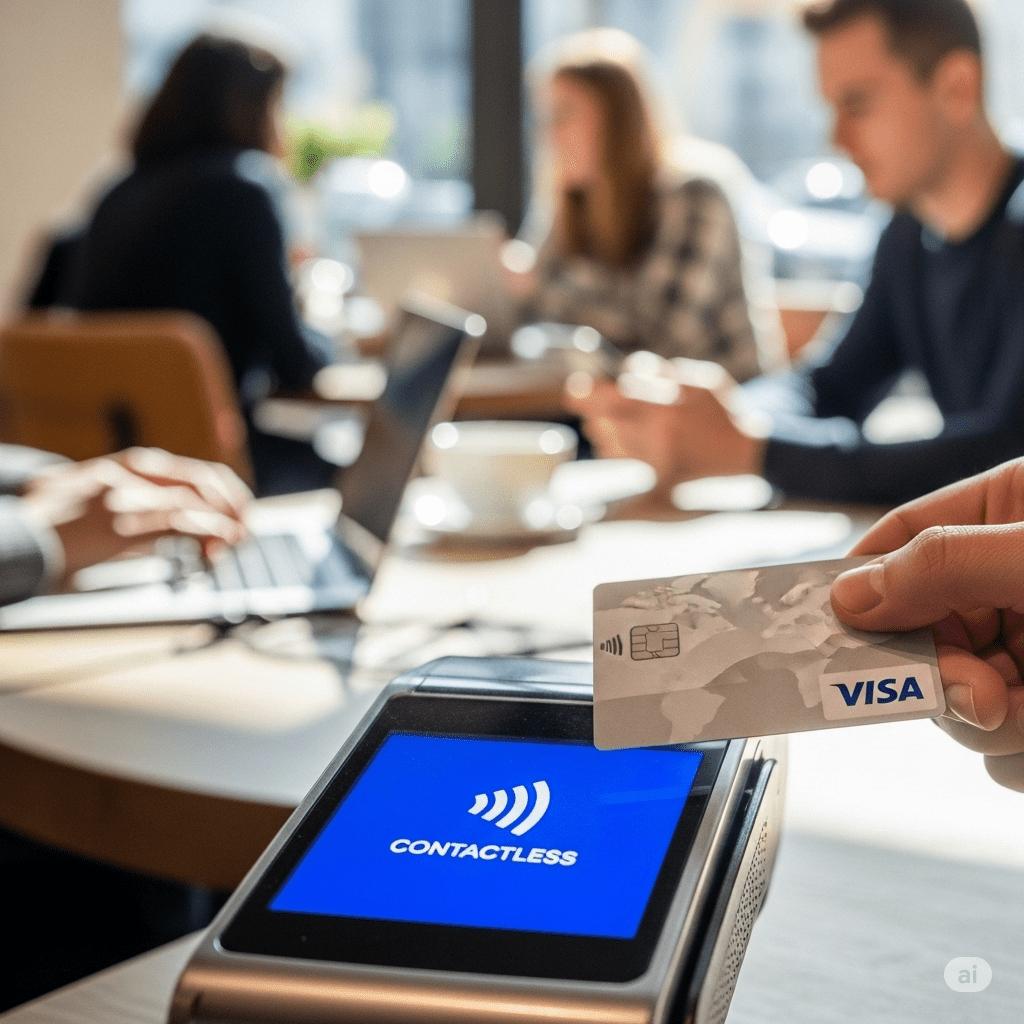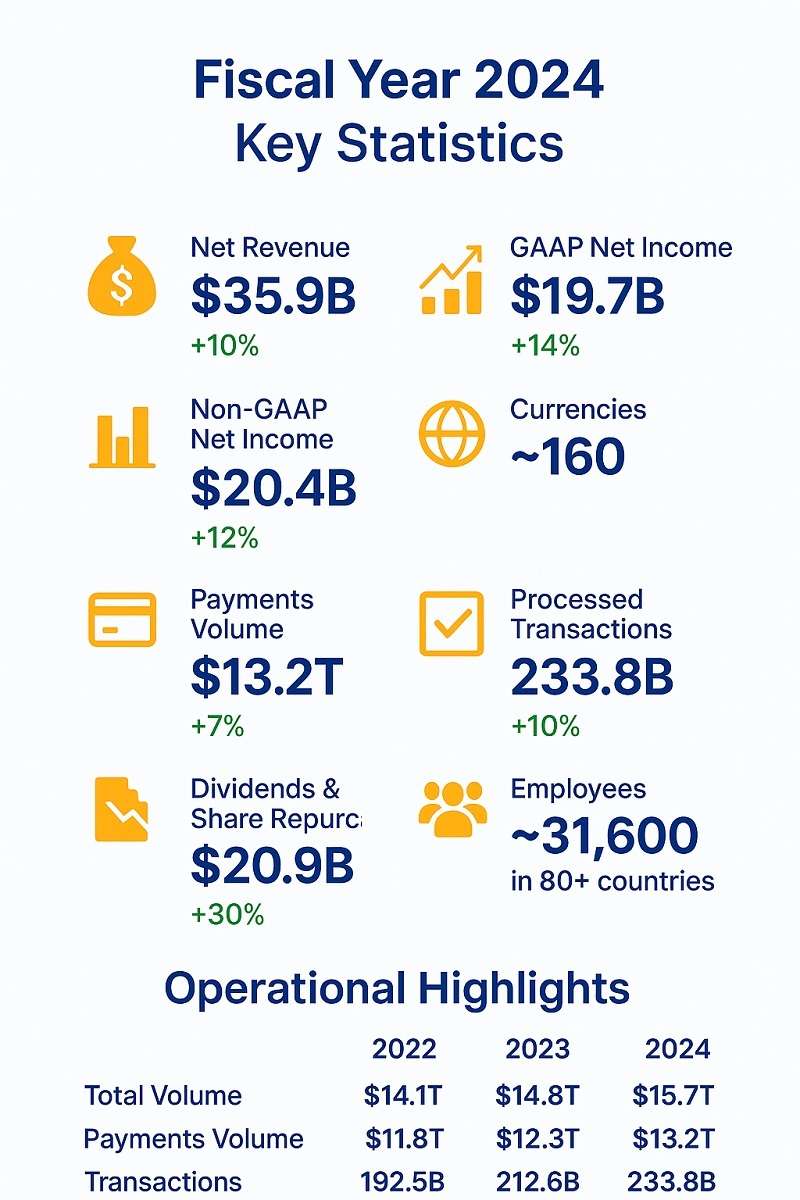- 9 August 2025
- No Comment
- 358
Visa Inc.: Story of the $13 Trillion Global Payments Leader

It’s a story of a company that quietly orchestrates how money flows in our digital world – that’s Visa today. Every day, its payment network handles hundreds of millions of transactions, amounting to roughly $15 trillion in volume annually. Once a bold experiment by a California banker, Visa has become a fintech powerhouse at the heart of the global credit card industry. Its story – full of visionary ideas, crisis and comeback, and fierce competition – reads like a financial thriller. In this article, we’ll journey from 1920s immigrant banks to today’s digital economy, explaining Visa’s evolution.
The Banking Pioneer: A.P. Giannini and Bank of America
Visa’s story roots go back to the early 20th century with Amadeo Peter Giannini, an Italian immigrant’s son who founded a new kind of bank on the West Coast. Giannini understood that middle-class immigrants were largely ignored by East Coast banks, so he built Bank of Italy (later Bank of America) in San Francisco to serve “the little fellows.” By offering loans to working-class families and foreign-born shopkeepers, his bank grew explosively.
By the late 1920s Bank of America boasted over $1 billion in assets – making it the largest bank in the world. Giannini’s vision was revolutionary: he wanted Bank of America to be a “financial supermarket” for ordinary Americans, offering not just savings and checking accounts but mortgages, auto loans, insurance, and even investment services for the masses.
Giannini’s inclusive banking philosophy set a cultural tone for the bank. He famously funded Sacramento and San Francisco rebuilds after major earthquakes, and even in panic times, he protected depositors’ savings personally. That “people-first” approach became part of Bank of America’s DNA – and would later influence the idea of a credit card for average consumers. For decades, the world’s finance leaders were big banks with trillion-dollar balance sheets. Giannini’s Bank of America showed that innovation and customer focus could create a banking giant as well.
Post-War Prosperity and the All-Purpose Credit Card
After World War II, the American middle class boomed. Wages were rising, suburbs were sprouting, and consumers were hungry to buy cars, appliances and furniture. This era saw one of the first big fintech shifts: consumer credit and installment buying. Rather than paying cash upfront, shoppers could now finance purchases. Gas stations, airlines, and department stores each rolled out their own credit cards. But carrying multiple store cards was awkward. Executives at Bank of America began to wonder: what if there were a single, general-purpose card for everyday purchases?
Bank of America’s president in the 1950s, S. Clark Beise, was a tech-forward thinker who wanted to turn his bank into an all-around financial services company. One of Beise’s young managers, Joseph P. Williams, had the exact plan. Williams studied the dozens of failed “all-purpose credit card” attempts and learned from them. He proposed a bold idea: give every bank customer a Visa precursor with a $300 credit line, no annual fee, a one-month grace period, and a relatively high 18% interest rate after that. These terms – a payment grace period and a set interest rate – became industry standards. Unlike a personal loan (which required paperwork with a loan officer), this card would instantly give consumers convenient credit wherever it was accepted.
In September 1958 Bank of America quietly unleashed the BankAmericard. In what was soon dubbed the “Fresno Drop,” the bank mailed some 65,000 pre-approved credit cards to homes in Fresno, California. The gamble was to see if consumers wanted a private credit card at all. Merchant partners like Florsheim Shoes and gas stations were recruited to accept the new card. At first, it seemed like a stroke of genius – a customer could now buy a new car, electronics or groceries on “plastic” without paying up front.
The Great Fresno Experiment: Crisis and Lesson
The Fresno test soon became a financial crisis. Most customers spent the “free money” in the first week, and more than 20% of them never paid their bills. Forged signatures and outright fraud followed, because BankAmericard was so new that no one knew how to prevent abuse. Within a year, Bank of America was losing about $9 million from this card program – a scandalous amount in the late 1950s. Joseph Williams, the card’s creator, was fired. In the bank’s own words, they had made an $8.8 million loss on the launch (about $20 million including all costs).
Yet the debacle proved a lesson: people wanted credit cards. BankAmericard’s instant mass mail-out showed that consumers would latch onto convenient electronic credit. To save the program, Bank of America imposed strict controls: it revoked cards from delinquent users, tightened signature requirements, and even sent apology letters to millions of customers. By May 1961, just a few years after the fiasco, the card program actually turned a profit for the first time. Banks realized this new payment system was viable if managed properly.
Licensing a Payment Network: BankAmericard Goes National
As BankAmericard regained its footing, a new competitor emerged. In the mid-1960s Master Charge (later Mastercard), an alliance of East Coast regional banks, launched a rival network. Federal rules of the day prevented any one bank from expanding nationwide, but a network could be licensed. Bank of America saw an opportunity: it began selling licenses to its BankAmericard system to other U.S. banks in 1966. In practice, a small bank in Arkansas or Washington State could issue BankAmericard to its customers, while Bank of America’s infrastructure processed the transactions. The bank focus shifted from issuing cards to processing payments and earning interchange fees (a slice of each transaction).
Within a few years, dozens of banks had joined the BankAmericard network. The “drops” of pre-approved cards continued across California and beyond – by the late 1960s over 100 million credit cards had been distributed in the U.S.. This licensing approach resembled an early fintech platform: one large payments processor (Bank of America’s system) serving many member banks as partners. It was highly scalable – more issuing banks meant more cards in market, more merchants accepting them, and more fees flowing back.
However, this rapid growth exposed flaws. Each credit card transaction involved multiple banks (issuing bank, merchant bank, etc.), requiring a complex clearing and settlement process. Fraud prevention remained a headache, especially since each bank used slightly different procedures. The system needed a backbone to manage all these players. Enter an unlikely innovator from Utah: Dee Hock.
Dee Hock: The Maverick Architect of Visa
Dee Ward Hock grew up on a farm in Utah and had little patience for rigid rules. After drifting through jobs and hating office hierarchy, he finally took a bank job out of necessity. By 1967, Hock was hired by the National Bank of Commerce in Seattle to manage that bank’s new BankAmericard program (the bank had bought a license from Bank of America). Hock threw himself into the challenge, despite his frugality and skepticism about credit cards. His first year proved the business worked: card usage took off, earning him a promotion to run the credit card division.
As the 1960s ended, the American economy hit another boom and every bank had some kind of card. But Hock noticed an urgent problem: the licensing network was chaotic. There was no central organization overseeing the rules, clearing or technology. Competing networks (BankAmericard vs. Master Charge) even limited which banks could participate in both – a contentious policy NBI (National BankAmericard Inc) would later repeal. Hock suggested all member banks form a committee to fix this chaos, and he became its chairman. His vision: a new cooperative, decentralized payment network – a self-governing system with no single owner bank calling all the shots.
Drawing inspiration from nature’s balance of competition and cooperation, Hock envisioned a “chaordic” organization (blend of chaos and order) for financial transactions. He believed no central “boss” should control the network; instead, rules would be set by the members themselves and enforced by shared technology. In 1970 Bank of America agreed. All member banks formed an independent company – National BankAmericard, Inc. (NBI) – to run the card program collectively. Hock was named its first president and CEO. For the first time, control of the payment network truly rested with the issuing banks, not just Bank of America.
From BankAmericard to Visa: A Global Brand Is Born
With NBI established, Hock set about unifying the card network under one brand. “BankAmericard” was a mouthful and awkward overseas (what bank wouldn’t want a piece of that pie? American Express, for one). Hock asked his team to find a simple, globally acceptable name.
In 1976 the engineers and bankers chose “Visa” – a word meaning “travel document,” easy to recognize in multiple languages and implying universal acceptance. That year, NBI itself was renamed Visa USA, and its international counterpart (IBANCO) became Visa International. Over the next decades, BankAmericard was phased out; everywhere it reappeared as Visa.
Under the Visa banner, growth exploded. The 1970s saw airlines, hotels, and retailers around the world adopting Visa and MasterCard as travelers’ new charge cards. In the United States, Visa introduced innovations like holograms on cards for security.
By the early 1980s Visa’s network processed about 60% of all credit card sales in America. It also rolled out traveler’s checks and debit products, further embedding itself in daily commerce. As Dee Hock later reflected, he had built “the organization that has changed the way the world pays”. His “chaordic” system of member banks sharing a common payments infrastructure proved so powerful that even after he retired in 1984, Visa continued thriving.
Rivalry and Regulation: The Rise of Mastercard and Antitrust Battles
Success breeds competition. In 1966 a consortium of Northeastern banks had spun off Master Charge (renamed Mastercard in 1979) to rival BankAmericard. Throughout the 1970s and 1980s, the two networks jockeyed for market share. MasterCard aggressively signed up merchants and international issuers.
In response, Visa/NBI adopted an anti-duality rule in 1971: member banks were prohibited from issuing MasterCard if they issued Visa, and vice versa. The idea was to lock in each bank’s loyalty and prevent banks from playing both sides.
However, this exclusivity quickly led to conflict. In late 1971 Arkansas’s Worthen Bank & Trust, a small Visa member, applied to issue MasterCard as well. NBI’s bylaw blocked them. Worthen sued in federal court, challenging the anti-duality rule as an illegal restraint of trade.
In 1972 the judge ruled for Worthen: Visa’s bylaw 2.16 was “a restraint of trade” under the Sherman Act. The court permanently enjoined NBI from enforcing the ban, forcing Visa to allow dual network membership.
The outcome was personal and traumatic for Dee Hock; he later said the episode left him “stunned” at the betrayal by Bank of America (which had quietly backed both sides behind his back). But the case opened the door to greater competition between networks, ensuring that no one payments scheme could unilaterally control all card traffic. Even after Worthen, Visa faced more legal battles.
By the 1990s, retailers and regulators accused Visa (and MasterCard) of unfair practices.
One issue was exclusivity: until the late 1990s, many banks had to “choose a side” and issue only Visa or only MasterCard. The U.S. Justice Department and courts found these rules anticompetitive.
In 2001–2003, Visa and MasterCard were forced to drop their bans on banks issuing Discover or American Express cards. Another flashpoint was the so-called “honor all cards” rule: merchants that accepted Visa credit cards had to also accept Visa debit cards, tying them to one network.
Retail giants like Walmart and others sued Visa for excessive swipe fees and restrictive rules. In 2003 Visa agreed to change those policies in a settlement to avoid further litigation.
In short, the evolution of Visa’s network was shaped not only by its own strategy but also by antitrust law, ensuring more competition for merchants and consumers.

Visa Today: The $13 Trillion Fintech Leader
By the 2000s Visa had cemented itself as a dominant global payment network. It never issued cards itself (no consumer debt on its books); instead it processed transactions and charged banks a fee. This “money-printing machine” model meant every swipe or online purchase generates revenue, and network effects keep its growth almost effortless. Even as competitors like Discover and American Express carved out niches, Visa’s ubiquity kept it on top of the credit card industry.
In March 2008, amid a looming financial crisis, Visa went public in the largest U.S. IPO ever – raising $17.9 billion.
Investors were eager for a slice of its fintech franchise. The stock soared 30% on day one, valuing the company at around $36 billion. Visa’s IPO success was a vote of confidence in its monopolistic-like status in electronic payments.
Today Visa is truly a global financial services titan. In its fiscal year 2024 (ending Sept 30, 2024), Visa processed about $16 trillion in total payments volume. It earned $35.9 billion in revenue that year. Its network spans 200+ countries, 150+ million merchant locations, and 4.6 billion payment credentials (cards, mobile wallets, etc.).
Visa processed about $16 trillion in total payments volume. It earned $35.9 billion in revenue that year. Its network spans 200+ countries, 150+ million merchant locations, and 4.6 billion payment credentials (cards, mobile wallets, etc.).
Visa’s investors love the business model: with minimal capital reinvestment, each additional user or merchant boosts the network’s value due to powerful network effects.
As of 2025, Visa remains on an upward trajectory. Share prices recently hit all-time highs, reflecting continued confidence in consumer spending and cashless trends. Its fintech innovations (contactless payments, tokenization, VisaNet) keep it secure against fraud, and its brand is synonymous with electronic finance. In this cashless era, Visa’s logo on your wallet is a gateway to the global economy – a long way from that first BankAmericard drop in Fresno.
Legacy of a Fintech Pioneer
Visa’s tale teaches that even the largest financial institutions can be upended by innovation and vision. From Giannini’s immigrant-friendly banking to Williams’ and Hock’s credit card revolutions, each chapter was fueled by a clear idea: make payments easier and more inclusive.
It shows how a payment system – at its core a network technology – can scale worldwide when run cleverly.
For finance professionals, Visa is more than just a case study in market dominance; it’s a lesson in managing growth, risk, and regulation in a complex system.
For consumers, it’s a reminder that behind the swipe of a credit card stands decades of strategy and technology. Today, Visa moves nearly half the card payments in the world, essentially orchestrating a vast digital payments ecosystem. Its influence on fintech and payment systems is profound: credit cards have reshaped consumer finance, and Visa’s network is the engine behind it all.
In the end, Visa’s journey from a local bank’s idea to a $13 trillion “money machine” underscores a timeless truth in finance: a well-designed network can become the backbone of commerce itself. As digital wallets and fintech apps emerge, Visa’s legacy in creating a truly global, reliable payment network will remain a pivotal chapter in modern financial history.



